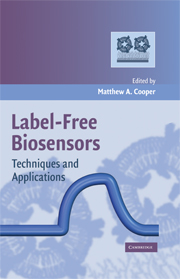Book contents
- Frontmatter
- Contents
- Contributors
- Preface
- LABEL-FREE BIOSENSORS
- 1 Label-free optical biosensors: An introduction
- 2 Experimental design
- 3 Extracting affinity constants from biosensor binding responses
- 4 Extracting kinetic rate constants from binding responses
- 5 Sensor surfaces and receptor deposition
- 6 Macromolecular interactions
- 7 Interactions with membranes and membrane receptors
- 8 Application of SPR technology to pharmaceutical relevant drug-receptor interactions
- 9 High-throughput analysis of biomolecular interactions and cellular responses with resonant waveguide grating biosensors
- 10 ITC-derived binding constants: Using microgram quantities of protein
- 11 Electrical impedance technology applied to cell-based assays
- Index
- Plate section
11 - Electrical impedance technology applied to cell-based assays
Published online by Cambridge University Press: 05 May 2010
- Frontmatter
- Contents
- Contributors
- Preface
- LABEL-FREE BIOSENSORS
- 1 Label-free optical biosensors: An introduction
- 2 Experimental design
- 3 Extracting affinity constants from biosensor binding responses
- 4 Extracting kinetic rate constants from binding responses
- 5 Sensor surfaces and receptor deposition
- 6 Macromolecular interactions
- 7 Interactions with membranes and membrane receptors
- 8 Application of SPR technology to pharmaceutical relevant drug-receptor interactions
- 9 High-throughput analysis of biomolecular interactions and cellular responses with resonant waveguide grating biosensors
- 10 ITC-derived binding constants: Using microgram quantities of protein
- 11 Electrical impedance technology applied to cell-based assays
- Index
- Plate section
Summary
INTRODUCTION
Cell-based assays are now well established in nearly all stages of drug discovery and development. Indeed, they are commonly applied to all the critical steps of the process from receptor target identification and validation, compound screening and structure–activity relationship (SAR) through to toxicology. This is due in a large part to their functional nature and their ability to introduce biological complexity to the drug discovery process at a much lower cost than in vivo testing. Additionally, these assays have been successfully scaled to meet the throughput needs of screening labs. Cellular assays complement and extend the knowledge of the more mechanistic interactions of receptors and ligands as understood from biochemical assays. Indeed, cell-based assays are commonly used iteratively with biochemical assays to inform the process and direct screening efforts.
Label-free cell-based assays are gaining broader acceptance in screening labs, as they provide novel read-outs of cellular signaling and carry with them many practical advantages to the drug discovery workflow. For example, the lack of labels greatly simplifies assay development, removing many steps, each of which requires optimization. Effort is also saved in the engineering of chimeric or tagged molecules, which are often altered to the point that they no longer maintain natural function, leaving results somewhat in question relative to the native biology of the system being tested.
Electrical impedance assays are novel label-free assays that fit well into the screening workflow. Originally used to study the basic physical properties of materials, impedance technology has evolved over time to yield instrumentation for the biophysical evaluation of living cells.
- Type
- Chapter
- Information
- Label-Free BiosensorsTechniques and Applications, pp. 251 - 278Publisher: Cambridge University PressPrint publication year: 2009
- 3
- Cited by



